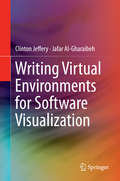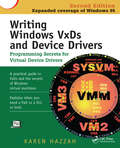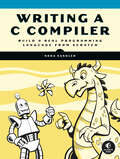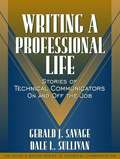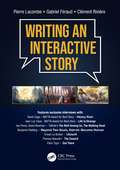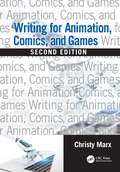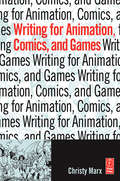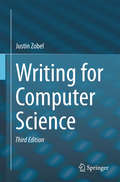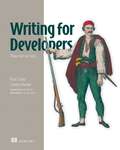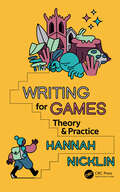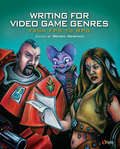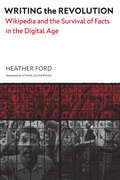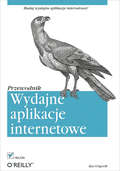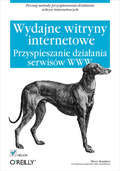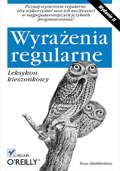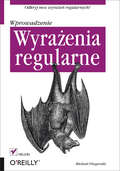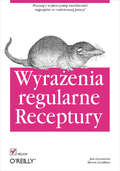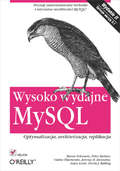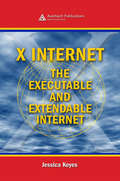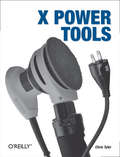- Table View
- List View
Writing Virtual Environments for Software Visualization
by Clinton Jeffery Jafar Al-GharaibehWriting Virtual Environments for Software Visualization book describes the software for a networked, 3D multi-user virtual environment that allows users to create and share remotely visualizations of program behavior. Collaborative virtual environments such as World of Warcraft or Second Life are a popular way to share interactive internet experiences, but they are complex and difficult to create Software visualization is an area that may enable important advances in our ability to understand and reduce the costs of maintaining software. Applying the former technology to this problem area will be valuable to distributed and multi-institutional software development and educational users. The author covers the major features of collaborative virtual environments and how to program them in a very high level language. The book also examines the application of popular game-like software technologies.
Writing Windows VxDs and Device Drivers
by Karen HazzahSoftware developer and author Karen Hazzah expands her original treatise on device drivers in the second edition of Writing Windows VxDs and Device Drivers. The book and companion disk include the author's library of wrapper functions that allow the progr
Writing a C Compiler: Build a Real Programming Language from Scratch
by Nora SandlerA fun, hands-on guide to writing your own compiler for a real-world programming language.Compilers are at the heart of everything programmers do, yet even experienced developers find them intimidating. For those eager to truly grasp how compilers work, Writing a C Compiler dispels the mystery. This book guides you through a fun and engaging project where you&’ll learn what it takes to compile a real-world programming language to actual assembly code.Writing a C Compiler will take you step by step through the process of building your own compiler for a significant subset of C—no prior experience with compiler construction or assembly code needed. Once you&’ve built a working compiler for the simplest C program, you&’ll add new features chapter by chapter. The algorithms in the book are all in pseudocode, so you can implement your compiler in whatever language you like. Along the way, you&’ll explore key concepts like:Lexing and parsing: Learn how to write a lexer and recursive descent parser that transform C code into an abstract syntax tree.Program analysis: Discover how to analyze a program to understand its behavior and detect errors.Code generation: Learn how to translate C language constructs like arithmetic operations, function calls, and control-flow statements into x64 assembly code.Optimization techniques: Improve performance with methods like constant folding, dead store elimination, and register allocation. Compilers aren&’t terrifying beasts—and with help from this hands-on, accessible guide, you might even turn them into your friends for life.
Writing a Professional Life: Stories of Technical Communicators On and Off the Job
by Gerald J. Savage Dale L. SullivanThis is the first collection of narratives by practicing technical communicators telling their own personal stories about the workplace and their lives on the job. The authors portray a wide range of jobs: writers, editors, interface designers, marketing writers, and trainers working in 9 different technical fields, including software, R&D, engineering , medicine, transportation, and telecommunications. The stories vividly demonstrate the unique power of narrative as a teaching and learning tool. Unlike fabricated cases, these real-life narratives show new and veteran technical writers at work on the job, dealing with tasks, clients, and co-workers, and revealing their insights, values, and attitudes about their work. The stories also show the skills required in the profession and the ethical and other issues raised in the course of the workday. For anyone interested in technical communication and professional writing.
Writing an Interactive Story
by Pierre Lacombe Gabriel Feraud Clement RiviereVideo games have become the world's largest leading cultural product. Though disputed in the past, the narrative qualities of video games have finally secured distinction in the realm of art. This is especially true for interactive games. Writing an Interactive Story will help the reader in navigating the creation process of interactive scripts, in addition to discovering behind the scenes narrative choices of renowned games, and will help you to harness your inner creativity. Guided by master interactive scriptwriters, the text presents its content in the form of a unique writing workshop. With interactive game writing, the player becomes the star of the work. Thanks to this method of storytelling, the morals of the game become resonant. This is because the weight of the narrative’s choices and consequences rest fully upon the player. It's the ultimate narrative. Whether you are a video game enthusiast, student, or professional, discover how to create a more immersive personalized experience than ever before and give your players the opportunity to write their own destiny through their choices. The methods, strategies, and secrets of this new art await you. Features exclusive interviews with: David Cage – BAFTA Award for Best Story – Heavy Rain Jean-Luc Cano - BAFTA Award for Best Story – Life Is Strange Joe Penny, David Bowman – Telltale’s The Wolf Among Us, The Walking Dead Benjamin Diebling – Beyond Two Souls, Detroit: Become Human Erwan Le Breton – Ubisoft Thomas Veauclin– The Council Fibre Tigre – Out There
Writing and Managing SOPs for GCP
by Susanne ProkschaThis book discusses managing SOPs for GCP from conception to retirement. It recommends approaches that have a direct impact on improving SOP and regulatory compliance. Throughout the text, the book provides a user's point of view to keep topics focused on the practical aspects of SOPs and SOP management.
Writing and Querying MapReduce Views in CouchDB: Tools for Data Analysts
by Bradley HoltIf you want to use CouchDB to support real-world applications, you'll need to create MapReduce views that let you query this document-oriented database for meaningful data. With this short and concise ebook, you'll learn how to create a variety of MapReduce views to help you query and aggregate data in CouchDB’s large, distributed datasets.You'll get step-by-step instructions and lots of sample code to create and explore several MapReduce views through the course of the book, using an example database you construct. To work with these different views, you’ll learn how to use the Futon web administration console and the cURL command line tool that come with CouchDB.Learn how the Map and Reduce steps work independently and together to index your dataUse the example database to create several temporary views based on different criteriaDiscover the uses of Map and Reduce JavaScript functionsConvert your temporary views to permanent views within a design documentLearn several options for querying the data within your viewsLimit the number of results returned, skip some results, or reverse the order of the outputGroup your results by exact keys or by parts of keysBradley Holt, co-founder of the creative services firm Found Line, is a web developer and entrepreneur ten years of PHP and MySQL experience. He began using CouchDB before the release of version 1.0. Bradley is an active member of the PHP community, and can be reached at bradley-holt.com.
Writing for Animation, Comics, and Games
by Christy MarxThis second edition of Writing for Animation, Comics, and Games expounds on the previous edition with more information on how to construct narratives for these three forms of visual storytelling media. Christy Marx’s book offers an in-depth look into scriptwriting and how to break into each of the featured industries. The text goes into detail on visual storytelling: how to compose exterior storytelling (animation, games) and interior/exterior storytelling (comics and graphic novels); as well as considerations for non-linear videogames. The advice within these pages can be used to build a transmedia career across animation, comics, graphic novels, and videogames. Key Features An insider's perspective on career rules of the road on writing for comics, videogames, and animation Written for beginners and professionals alike A nuts-and-bolts guide to script formats, terminology, networking, and valuable advice on writing for each medium Author Bio Based in Northern California, Christy Marx is an award-winning writer, story editor, TV series developer, game designer, and narrative designer. Her many credits include Babylon 5; Captain Power and Soldiers of the Future; The Twilight Zone; G.I. Joe; Jem and the Holograms; Spider-Man; He-Man; X-Men Evolution; Teenage Mutant Ninja Turtles; Conan the Adventurer; Birds of Prey; Amethyst; The Sisterhood of Steel; Sierra On-Line adventure games; PC, MMO, and console games; Zynga mobile games; and more. For full credits, visit www.christymarx.com.
Writing for Animation, Comics, and Games
by Christy MarxWriting for Animation, Comics, and Games explains the practical aspects of creating scripts for animation, comics, graphic novels, and computer games. It details how you can create scripts that are in the right industry format, and follow the expected rules for you to put your best foot forward to help you break-in to the trade. This book explains approaches to writing for exterior storytelling (animation, games); interior/exterior storytelling (comics and graphic novels), as well as considerations for non-linear computer games in the shortest, pithiest, and most economical way. The author offers insider's advice on how you can present work as professional, how to meet deadlines, how visual writing differs from prose, and the art of collaboration.
Writing for Computer Science
by Justin ZobelAll researchers need to write or speak about their work, and to have research that is worth presenting. Based on the author's decades of experience as a researcher and advisor, this third edition provides detailed guidance on writing and presentations and a comprehensive introduction to research methods, the how-to of being a successful scientist. Topics include: · Development of ideas into research questions; · How to find, read, evaluate and referee other research; · Design and evaluation of experiments and appropriate use of statistics; · Ethics, the principles of science and examples of science gone wrong. Much of the book is a step-by-step guide to effective communication, with advice on: · Writing style and editing; · Figures, graphs and tables; · Mathematics and algorithms; · Literature reviews and referees' reports; · Structuring of arguments and results into papers and theses; · Writing of other professional documents; · Presentation of talks and posters. Written in an accessible style and including handy checklists and exercises, Writing for Computer Science is not only an introduction to the doing and describing of research, but is a valuable reference for working scientists in the computing and mathematical sciences.
Writing for Developers: Blogs that get read
by Piotr Sarna Cynthia DunlopPragmatic methods for writing blogs, articles, and other technical pieces that stand out from the crowd!Do you want to connect with your community, share your state-of-the-art achievements, and help your peers benefit from your hard-fought lessons learned? Do you want to get the kind of attention that expands your career? Master the art of writing engineering blog posts and articles! This comprehensive guide shows you how to create content your fellow developers will love to read and share. Writing for Developers is full of the practical tips, tricks, and techniques you need to translate the ideas floating around your head into content that&’s clear and compelling, including how to: • Pinpoint topics that make intriguing posts • Apply popular blog post design patterns • Rapidly plan, draft, and optimize blog posts • Make your content clearer and more convincing to technical readers • Tap AI for revision while avoiding misuses and abuses • Increase the impact of all your technical communications Whether you&’re brand new to writing, or a seasoned hand who wants more attention for your work, Writing for Developers will help ensure your writing resonates with readers. This isn&’t a generic writing guide—from start to finish, the book is laser-focused on technical topics, writers, and audiences. Authors Piotr Sarna and Cynthia Dunlop combine their differing perspectives as an engineer and professional writer to help you write compelling works. You&’ll learn through detailed examples, methodical strategies, and a &“punk rock DIY attitude!&” Foreword by Bryan Cantrill. Afterword by Scott Hanselman. About the technology A well-crafted technical article can spark a new idea, demystify a technology, expand your perspective, or save you from going down a disastrous path. Even if you don&’t consider yourself a &“good writer,&” you can make a difference by sharing insights and advancing the community. This practical guide shows you how to create blogs, articles, and other content your fellow developers will want to read and share. About the book Writing for Developers introduces seven popular patterns for modern engineering blogs—such as &“The Bug Hunt,&” &“We Rewrote It in X,&” and &“How We Built It&”—and helps you match these patterns with your ideas. This book covers the entire writing process, from brainstorming, planning, and revising, to promoting your blog in ways that build reputation and generate further opportunities. What's inside • Rapidly plan, draft, and review your content • Build on popular blog post design patterns • Support your writing with AI • Increase the impact of all your communications About the reader For developers and engineers of all ability levels—even if you&’re not a native English speaker and never took a writing class in your life. About the author Piotr Sarna is a software engineer and an experienced book and blog author. Cynthia Dunlop has been writing for and with developers for 20+ years.
Writing for Games: Theory and Practice
by Hannah NicklinFocussing on the independent videogames sector, this book provides readers with a vocabulary to articulate and build their games writing practice; whether studying games or coming to games from another storytelling discipline. Writing for Games offers resources for communication, collaboration, reflection, and advocacy, inviting the reader to situate their practice in a centuries-long heritage of storytelling, as well as considering the material affordances of videogames, and the practical realities of working in game development processes. Structured into three parts, Theory considers the craft of both games and writing from a theoretical perspective, covering vocabulary for both game and story practices. Case Studies uses three case studies to explore the theory explored in Part 1. The Practical Workbook offers a series of provocations, tools and exercises that give the reader the means to refine and develop their writing, not just for now, but as a part of a life-long practice. Writing for Games: Theory and Practice is an approachable and entry-level text for anyone interested in the craft of writing for videogames. Hannah Nicklin is an award-winning narrative and game designer, writer, and academic who has been practising for nearly 15 years. She works hard to create playful experiences that see people and make people feel seen, and also argues for making games a more radical space through mentoring, advocacy, and redefining process. Trained as a playwright, Nicklin moved into interactive practices early on in her career and is now the CEO and studio lead at Danish indie studio Die Gute Fabrik, which most recently launched Mutazione in 2019.
Writing for Multimedia and the Web: A Practical Guide to Content Development for Interactive Media
by Timothy GarrandLearning how to write for just one type of interactive media, such as web sites or games, is not enough! To be truly successful as an interactive writer or designer, you need to understand how to create content for all types of new media.Writing for Multimedia and the Web is the most comprehensive guide available for interactive writing. It covers web sites, computer games, e-learning courses, training programs, immersive exhibits, and much more. Earlier editions have garnered rave reviews as a writing handbook for multimedia and web professionals, as well as a classroom text for interactive writing and design.New Sections and Completely Updated Chapters:*Writing a corporate web site: T. Rowe Price*Creating blogs and podcasts*Web writing tips from usability experts*Optimizing text for web search engines*Defining the user with use cases and user scenarios*Dealing with web editors*Software for organizing and writing interactive media content*Script formats for all types of multimedia and web projects*Writing careers
Writing for Video Game Genres: From FPS to RPG
by Wendy DespainThis book, written and edited by members of the International Game Developers Association (IGDA) Game Writing Special Interest Group, follows the acclaimed Professional Techniques for Video Game Writing to deliver practical advice from seasoned veterans on the special challenges of writing for first-person shooter games (FPS), role-playing games (R
Writing the Revolution: Wikipedia and the Survival of Facts in the Digital Age
by Heather FordA close reading of Wikipedia&’s article on the Egyptian Revolution reveals the complexity inherent in establishing the facts of events as they occur and are relayed to audiences near and far.Wikipedia bills itself as an encyclopedia built on neutrality, authority, and crowd-sourced consensus. Platforms like Google and digital assistants like Siri distribute Wikipedia&’s facts widely, further burnishing its veneer of impartiality. But as Heather Ford demonstrates in Writing the Revolution, the facts that appear on Wikipedia are often the result of protracted power struggles over how data are created and used, how history is written and by whom, and the very definition of facts in a digital age. In Writing the Revolution, Ford looks critically at how the Wikipedia article about the 2011 Egyptian Revolution evolved over the course of a decade, both shaping and being shaped by the Revolution as it happened. When data are published in real time, they are subject to an intense battle over their meaning across multiple fronts. Ford answers key questions about how Wikipedia&’s so-called consensus is arrived at; who has the power to write dominant histories and which knowledges are actively rejected; how these battles play out across the chains of circulation in which data travel; and whether history is now written by algorithms.
Wska?niki w j?zyku C. Przewodnik
by Richard M. ReeseJe?li chcesz b?yskawicznie opanowa? programowanie w j?zyku C, si?gnij po t? ksi??k?! Gdy ju? poznasz podstawy, nauczysz si? tak?e korzysta? ze wska?ników. To prawdziwa zmora wszystkich programistów, bowiem b??dne wykorzystanie wska?nika mo?e w okamgnieniu zrujnowa? Twój program. Zobacz, jak tego unikn?? i zaprzyja?ni? si? ze wska?nikami.Inne ksi??ki opisuj? wska?niki w jednym lub dwu rozdzia?ach, natomiast my po?wi?cili?my im ca?? ksi??k?. Dzi?ki temu dog??bnie poznasz ten mechanizm, zrozumiesz go i przekonasz si?, ?e przy odrobinie uwagi nie jest on wcale taki straszny! W trakcie lektury wykorzystasz wska?niki na funkcj?, przygotujesz tablic? wska?ników oraz zobaczysz, jak wspó?dzia?aj? one z ?a?cuchami znaków. Twoj? uwag? z pewno?ci? zwróc? fragmenty omawiaj?ce zabezpieczenia oraz niew?a?ciwe wykorzystanie wska?ników. Ksi??ka ta jest jedyn? pozycj? na rynku w ca?o?ci po?wi?con? wska?nikom w j?zyku C. To lektura obowi?zkowa ka?dego programisty!Poznaj:koncepcj? wska?nikówzastosowanie tablic wska?nikówfunkcje dynamicznego alokowania pami?cizagro?enia wynikaj?ce ze stosowania wska?nikówOdkryj tajniki wska?ników w j?zyku C i wykorzystaj ich potencja?!
Wydajne aplikacje internetowe. Przewodnik
by Ilya Grigorik"Buduj wydajne aplikacje internetowe!Aplikacje internetowe systematycznie wypieraj? swoje klasyczne odpowiedniki. Edytory tekstu, programy graficzne czy systemy CRM w wersji online nikogo ju? nie zaskakuj?. Coraz bardziej skomplikowane narz?dzia dost?pne za po?rednictwem przegl?darki internetowej wymagaj? od deweloperów znakomitej znajomo?ci protoko?ów HTTP, XHR, WebSocket i nie tylko. Dzi?ki tej wiedzy s? oni w stanie tworzy? wydajne aplikacje, które spe?ni? oczekiwania u?ytkowników.Ta ksi??ka to najlepsze ?ród?o informacji po?wi?cone protoko?om internetowym. Przygotowana przez in?yniera Google’a, odpowiedzialnego za wydajno??, zawiera szereg cennych informacji, które pozwol? Ci ulepszy? Twoje w?asne aplikacje. W trakcie lektury dowiesz si?, jak osi?gn?? optymaln? wydajno?? protoko?ów TCP, UDP i TLS oraz jak wykorzysta? mo?liwo?ci sieci mobilnych 3G/4G. W kolejnych rozdzia?ach zaznajomisz si? z histori? protoko?u HTTP, poznasz jego mankamenty oraz sposoby rozwi?zywania problemów. Zorientujesz si? te? w nowo?ciach, jakie ma wprowadzi? HTTP w wersji 2.0. W ko?cu odkryjesz, co mog? Ci zaoferowa? WebSocket oraz WebRTC, a dodatkowo poznasz skuteczne techniki strumieniowania danych w sieci Internet. Ksi??ka ta jest obowi?zkow? lektur? dla ka?dego programisty tworz?cego aplikacje internetowe!Dzi?ki tej ksi??ce: poznasz najlepsze techniki optymalizacji ruchu w sieci wykorzystasz potencja? sieci bezprzewodowych oraz mobilnych zaznajomisz si? z histori? protoko?u HTTP i jego mankamentami zobaczysz, jak nawi?za? po??czenie peer-to-peer za pomoc? WebRTC zbudujesz wydajn? aplikacj? internetow?Poznaj niuanse pozwalaj?ce na zbudowanie szybkiej aplikacji internetowej!"
Wydajne witryny internetowe. Przyspieszanie dzia?ania serwisów WWW
by Steve SoudersPoznaj metody przyspieszania dzia?ania witryn internetowychJak zredukowa? ilo?? ??da? HTTP?W jaki sposób skompresowa? przesy?ane dane?Jak zoptymalizowa? interfejsy w technologii Ajax?Tempo rozwoju internetu przeros?o naj?mielsze oczekiwania. Ka?dego dnia w sieci pojawiaj? si? nowe witryny WWW i aplikacje internetowe, przyci?gaj?ce rzesze u?ytkowników. Niestety, nadal najwi?kszym problemem internautów jest niska przepustowo?? ??czy, która cz?sto skutecznie zniech?ca do korzystania z bardziej rozbudowanych serwisów internetowych. Przed projektantami witryn WWW oraz twórcami interfejsów u?ytkownika dla aplikacji sieciowych stoi powa?ne wyzwanie - trzeba zoptymalizowa? i przyspieszy? funkcjonowanie tego, co u?ytkownik widzi w przegl?darce. W ci?gu ostatnich kilku lat pojawi?o si? sporo ciekawych rozwi?za?, znacznie u?atwiaj?cych ten proces, lecz stworzenie naprawd? wydajnego przegl?darkowego interfejsu u?ytkownika wymaga opanowania wielu zagadnie?.Ksi??ka "Wydajne witryny internetowe. Przyspieszanie dzia?ania serwisów WWW" to kompleksowy przegl?d i omówienie czynników sk?adaj?cych si? na optymalny interfejs u?ytkownika aplikacji internetowej. Czytaj?c j?, dowiesz si?, jak przyspieszy? dzia?anie witryn WWW poprzez ograniczanie ilo?ci przesy?anych danych, buforowanie ich i kompresowanie, optymalne rozmieszczenie elementów graficznych i zdefiniowanie stylów CSS. Nauczysz si? tak?e ogranicza? rozmiary skryptów, korzysta? z technologii Ajax i przyspiesza? dzia?anie elementów utworzonych za pomoc? programu Adobe Flash.Ograniczanie ilo?ci ??da? HTTPKorzystanie z nag?ówka ExpiresStosowanie kompresji GZIPOdpowiednie umieszczanie definicji stylów oraz kodów skryptów w dokumentach HTMLOptymalne korzystanie z CSSStosowanie zewn?trznych plików ze skryptamiRedukcja ilo?ci zapyta? DNSBuforowanie zapyta? Ajax Twórz wydajne i szybko dzia?aj?ce witryny internetowe.
Wyra?enia regularne. Leksykon kieszonkowy. Wydanie II
by Tony StubblebinePoznaj wyra?enia regularne, aby wykorzysta? moc ich mo?liwo?ci w najpopularniejszych j?zykach programowania! Chcesz pozna? przepisy na wyra?enia regularne? Chcesz wykorzystywa? mo?liwo?ci Unicode w j?zyku Ruby, Java, Perl, PHP, Pyton, C oraz .NET? Chcesz wiedzie?, jak stosowa? wyra?enia regularne zaimplementowane w ró?nych j?zykach programowania? Wyra?enia regularne s? narz?dziem umo?liwiaj?cym analiz? i modyfikowanie tekstu przez dopasowywanie wzorców. S? one ?a?cuchem znaków zawieraj?cym kombinacj? normalnych znaków oraz specjalnych metaznaków i metasekwencji, a dopasowywanie wzorców polega na odszukaniu fragmentu ?a?cucha opisywanego przez wyra?enie regularne. Wyra?enia te znajduj? zastosowanie przy sprawdzaniu warto?ci zmiennych, zmianie formatu, przeprowadzaniu z?o?onych operacji wyszukiwania oraz weryfikowaniu poprawno?ci danych tekstowych. Ksi??ka "Wyra?enia regularne. Leksykon kieszonkowy" stanowi podr?czny niezb?dnik dla wszystkich pisz?cych programy przetwarzaj?ce teksty. Oprócz zagadnie? podstawowych, takich jak sk?adnia wyra?e? regularnych oraz operacje, w których s? wykorzystywane, leksykon zawiera inne niezwykle pomocne i bardziej zaawansowane informacje dotycz?ce na przyk?ad narz?dzi obs?ugi wyra?e? w j?zyku Ruby oraz na serwerze WWW Apache. Czytaj?c t? ksi??k?, nie tylko zdob?dziesz konkretn? wiedz?, ale równie? niezb?dne umiej?tno?ci praktyczne -- mi?dzy innymi dowiesz si?, jak wykorzysta? znajomo?? wyra?e? regularnych we wszystkich ?rodowiskach. Metaznaki, tryby oraz konstrukcje Reprezentacja i klasy znaków Komentarze i modyfikatory trybów Narz?dzia obs?ugi wyra?e? regularnych w j?zyku Ruby oraz na serwerze WWW Apache Operatory wyra?e? regularnych w j?zyku Perl 5.8 Obiekty i metody do obs?ugi wyra?e? regularnych w j?zyku JavaScript Funkcje obs?ugi wyra?e? regularnych w j?zyku PHP i edytorze vi Obiekty i funkcje wyra?e? regularnych w j?zyku Pyton Programy obs?ugiwane z wiersza polece? Wyra?enia regularne to nieocenione narz?dzia w pracy programisty -- nie mo?esz si? bez nich obej??!
Wyra?enia regularne. Wprowadzenie
by Michael FitzgeraldWyra?enia regularne to wzorce, które pozwalaj? opisa? ?a?cuchy znaków. Brzmi to gro?nie, wygl?da jeszcze gorzej, ale ka?dy programista pr?dzej czy pó?niej si? z nimi spotka i… doceni ich pot?g?! Ci??ko sobie wyobrazi? wyszukiwanie, zast?powanie oraz sprawdzanie poprawno?ci danych bez wykorzystania potencja?u wyra?e? regularnych. Czas po?wi?cony na ich opanowanie zwróci si? b?yskawicznie i z nawi?zk?!Ta wspania?a ksi??ka wprowadzi Ci? w ?wiat wyra?e? regularnych szybko i bezbole?nie. Ju? za chwil? wykorzystasz podstawowe elementy wyra?e?, a ka?dy kolejny rozdzia? dostarczy Ci coraz bardziej zaawansowanych narz?dzi. W trakcie lektury nauczysz si? korzysta? z granic, klas znaków, grup i odniesie?. Ponadto dowiesz si?, jak wykorzysta? mo?liwo?ci Perla w zakresie transformacji tekstów. Ksi??ka ta jest wyj?tkowym podr?cznikiem, który musi znale?? si? na pó?ce ka?dego programisty!Sprawd? ju? teraz:potencja?, jaki kryj? wyra?enia regularnemetody szybkiego wyszukiwania i zast?powania ci?gów znakówsposoby korzystania z wyra?e? w ró?nych j?zykach programowaniamo?liwo?ci wyra?e? regularnych w zakresie kontroli poprawno?ci wprowadzonych danych Zaoszcz?d? czas dzi?ki wyra?eniom regularnym!
Wyrażenia regularne. Receptury (in Polish)
by Steven Levithan Jan GoyvaertsWyraenie regularne (ang. regexp) to inaczej wzorzec, ktry okrela zbir dopasowanych acuchw znakw. Brzmi to prosto. Jednak przy pierwszym spotkaniu z wyraeniami wcale tak...
Wysoko wydajne MySQL. Optymalizacja, archiwizacja, replikacja. Wydanie II
by Derek J. Balling Baron Schwartz Peter Zaitsev Vadim Tkachenko Arjen Lentz Jeremy D. ZawodnyPoznaj zaawansowane techniki i nieznane mo?liwo?ci MySQL! Jak za pomoc? MySQL budowa? szybkie i niezawodne systemy?Jak przeprowadza? testy wydajno?ci?Jak optymalizowa? zaawansowane funkcje zapyta??MySQL jest ci?gle udoskonalanym i rozbudowywanym oprogramowaniem. Stale zwi?ksza si? tak?e liczba jego u?ytkowników, w?ród których nie brak wielkich korporacji. Wynika to z niezawodno?ci i ogromnej, wci?? rosn?cej wydajno?ci tego systemu zarz?dzania. MySQL sprawdza si? tak?e w bardzo wymagaj?cych ?rodowiskach, na przyk?ad aplikacjach sieciowych, ze wzgl?du na du?? elastyczno?? i mo?liwo?ci, takie jak zdolno?? wczytywania silników magazynu danych jako rozszerze? w trakcie dzia?ania bazy.Ksi??ka "Wysoko wydajne MySQL. Optymalizacja, archiwizacja, replikacja. Wydanie II" szczegó?owo prezentuje zaawansowane techniki, dzi?ki którym mo?na w pe?ni wykorzysta? ca?y potencja?, drzemi?cy w MySQL. Omówiono w niej praktyczne, bezpieczne i pozwalaj?ce na osi?gni?cie du?ej wydajno?ci sposoby skalowania aplikacji. Z tego przewodnika dowiesz si?, w jaki sposób projektowa? schematy, indeksy i zapytania. Poznasz tak?e zaawansowane funkcje MySQL, pozwalaj?ce na uzyskanie maksymalnej wydajno?ci. Nauczysz si? tak dostraja? serwer MySQL, system operacyjny oraz osprz?t komputerowy, aby wykorzystywa? pe?ni? ich mo?liwo?ci. Architektura MySQLTesty wydajno?ci i profilowanieOptymalizacja schematu i indeksowanieOptymalizacja wydajno?ci zapyta?Przechowywanie koduUmieszczanie komentarzy w kodzie sk?adowymKonfiguracja serweraDostrajanie i optymalizacja wyszukiwania pe?notekstowegoSkalowalno?? i wysoka dost?pno??Wydajno?? aplikacjiKopia zapasowa i odzyskiwanieInterfejs SQL dla polece? spreparowanychBezpiecze?stwo Twórz doskonale dostrojone aplikacje MySQL
Wyznania mówcy. Spraw, by ludzie Ci? s?uchali
by Scott BerkunSztuka bycia gwiazd? wyst?pie? publicznych Jak hipnotyzowa? s?uchaczy i porywa? t?umyJak by? rozlu?nionym, zabawnym i kompetentnym mówc?Jak stosowa? podr?czne sztuczki zawodowcówScott Berkun prezentuje przyst?pny i praktyczny poradnik, pozwalaj?cy roz?o?y? sztuk? przemawiania na czynniki pierwsze i dog??bnie j? zrozumie?. Szerokie do?wiadczenie autora u?atwia zrozumienie l?ku przed wyst?powaniem publicznym, gdy? wi?kszo?? tego, czego si? obawiamy, istnieje wy??cznie w naszym umy?leMichael Lopp, autor ksi??ki Managing HumansCyceron powiedzia?, ?e nale?y sprawi?, aby s?uchacze byli uwa?ni, otwarci oraz ufni. Jak to osi?gn??? Po pierwsze nale?y unika? pretensjonalnych nawi?za? do martwych ludzi. Po drugie nale?y przeczyta? przydatny i zabawny poradnik przemawiania, napisany przez Scotta BerkunaJay Heinrichs, autor ksi??ki Thank You for ArguingSpó?niasz si? na w?asn? prelekcj?, laptop zaczyna podejrzanie dymi?, na sali jest dziesi?? osób, spo?ród których po?owa przysypia, a reszta ?mieje si? szyderczo, stres parali?uje Ci struny g?osowe, a na dodatek gdzie? w okolicy podst?pnie czai si? szef, czekaj?c na Twoj? wpadk?. A jednak mimo to przeprowadzasz znakomit? i profesjonaln? prezentacj?, a zebrani skanduj? Twoje imi?, prosz?c o wi?cej. Przesada? Mo?e tylko odrobin?.Autor tego hipnotycznego poradnika doskonale zna si? na rzeczy — w trakcie swojej kariery wyg?osi? setki wyk?adów i prze?y? wi?kszo?? nieprzyjemnych, tragicznych czy kr?puj?cych sytuacji, które na ogó? przera?aj? przysz?ych i niedosz?ych mówców. Praktyczne lekcje i zaskakuj?ce wyznania pozwol? Ci popatrze? z zupe?nie innej perspektywy na sztuk? przemówie? publicznych, perswazji, skutecznej komunikacji, uczenia si? oraz nauczania. Chcesz si? uczy?? Ucz si? od mistrza.Dowiedz si?, jak nie zanudzi? s?uchaczy na ?mier?.Odkryj, co robi?, kiedy sprawy id? nie po Twojej my?li.Sprawd?, jak nauczy? innych czegokolwiek.Poznaj sztuk? odpowiadania na niewygodne pytania.Naucz si? pokonywa? l?k i parali?uj?cy strach.Oce?, czego mo?esz nauczy? si?, ?ledz?c wyst?py komików."Przeczyta?am pierwsz? stron?, wy??czy?am telefon i komputer, bo wiedzia?am, ?e nie ma si? co rozprasza?, ta ksi??ka to naprawd? CO?!" -- http://onepress.pl/recenzjamiwypu.phtml">tak o ksi??ce Scotta Berkuna pisze polska bestsellerowa autorka>>
X Internet: The Executable and Extendable Internet
by Jessica KeyesThe executable Internet (X Internet) brings new power and sophistication in delivering services and capabilities to users. The X Internet, both the executable Internet and the extended Internet, fundamentally alters the desktop and Internet landscapes by blurring their distinction both online and off-resulting in a new era of information technology
X Power Tools
by Chris TylerThis book puts you in charge of the most flexible and adaptable graphical interface in the computer industry. The X Window System underlies graphical desktops on Linux and Unix systems, and supports advanced features of modern graphics cards. More people use the X Window System than ever before, but there are few books about X in print. X Power Tools fills that hole with the most practical and up-to-date information available.Written in O'Reilly's popular Power Tools format, X Power Tools offers dozens of standalone articles, thoroughly cross-referenced, on useful tools and techniques for using X. This unique inside look at X gives Unix/Linux system administrators, owners of self-administered systems, and power users a lot of useful ways to harness the power of this system effectively. This book: Offers a thorough grounding in X configuration and how the system worksProvides the complete ins and outs of changing a desktop's behavior, such as fonts, keyboard settings, and remote securityIncludes articles on how to take advantage of X's "network transparency" -- its ability to display graphical applications on a remote machineExplores intriguing areas such as using multiple monitors, building kiosks, and accessibilityFeatures discussions on X Window innovations and the future of the systemX Power Tools covers configuration and use of X, focusing on Linux but also including notes on other operating systems such as Solaris and FreeBSD. Each article in the book gives you insight into X; the entire book gives you a real grasp on this system and what you can do with it.
